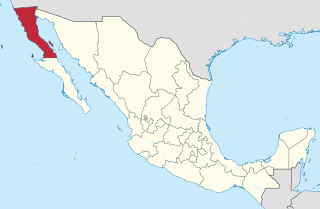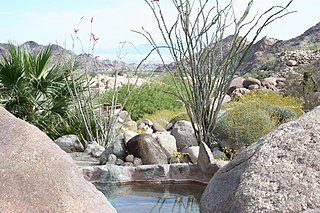A Molokan is a member of various Spiritual Christian religion that evolved from Eastern Christianity in the East Slavic lands. Their traditions—especially dairy consumption during Christian fasts—did not conform to those of the Russian Orthodox Church, and they were regarded as heretics (sektanty). The term Molokan is an exonym used by their Orthodox neighbors; they tend to identify themselves as Spiritual Christians.

Baja California, officially the Free and Sovereign State of Baja California is a state in Mexico. It is the northernmost and westernmost of the 32 federal entities of Mexico. Before becoming a state in 1952, the area was known as the North Territory of Baja California. It has an area of 70,113 km2 (27,071 sq mi) and comprises the northern half of the Baja California Peninsula, north of the 28th parallel, plus oceanic Guadalupe Island. The mainland portion of the state is bordered on the west by the Pacific Ocean; on the east by Sonora, the U.S. state of Arizona, and the Gulf of California; on the north by the U.S. state of California; and on the south by Baja California Sur.

Ensenada is a coastal city in Mexico, the third-largest in Baja California. Lying 125 kilometres (78 mi) south of San Diego on the Baja California Peninsula, it is locally referred to as La Cenicienta del Pacífico, "The Cinderella of the Pacific".

The Kumeyaay, also known as Tipai-Ipai or by their historical Spanish name Diegueño, is a tribe of Indigenous peoples of the Americas who live at the northern border of Baja California in Mexico and the southern border of California in the United States. Their Kumeyaay language belongs to the Yuman–Cochimí language family.

The Valle de Guadalupe is an area of Ensenada Municipality, Baja California, Mexico that is an increasingly popular tourist destination for wine and Baja Med cuisine. It is located 20 kilometres (12 mi) north of the City of Ensenada and 113 kilometres (70 mi) southeast of the border crossing from San Diego to Tijuana. It includes communities such as Ejido El Porvenir, Francisco Zarco, San Antonio de las Minas and Colonia Articulo 115, and combined had 5,859 inhabitants according to the 2010 census.

The municipality of Ensenada is the fourth largest municipality in Mexico with a land area of 19,526.8 km2 (7,539.3 sq mi), about the same size as Hidalgo state and larger than 5 states in Mexico.

Mexican wine and wine making began with the arrival of the Spanish in the 16th century, when they brought vines from Europe to modern day Mexico, the oldest wine-growing region in the Americas. Although there were indigenous grapes before the Spanish conquest, the Spaniards found that Spanish grapevines also did very well in the colony of New Spain (Mexico) and by the 17th century wine exports from Spain to the New World fell. In 1699, Charles II of Spain prohibited wine making in Mexico, with the exception of wine for Church purposes. From then until Mexico’s Independence, wine was produced in Mexico only on a small scale.
Baja Med is a term conceived by Chef Miguel Ángel Guerrero that refers to fusion cuisine of Mexican cuisine, such as chicharrón and cotija cheese, with those of Mediterranean, such as olive oil, and Asian cuisine, such as lemongrass. Baja Med dishes showcase the fresh produce and seafood of Baja California.
Hans Backhoff Escudero was a Mexican winemaker whose work in establishing the Monte Xanic winery helped to establish the wine industry in Baja California. His wines were the first from Mexico to receive international recognition.
Monte Xanic is Mexico's first boutique winery. Located in the Valle de Guadalupe, it was founded by five partners with the aim of making the best wine possible in the country. Despite economic and cultural challenges, the winery started a revolution in Mexican wine making. It has been credited with establishing the current status of the Valle de Guadalupe for wine, both in Mexico and abroad.

The Baja California wine industry is concentrated in a small area of the state of Baja California, Mexico. Most of the production is in the Valle de Guadalupe, there is also grape and wine production in some neighboring valleys. These valleys all have Mediterranean-type microclimates instead of desert thanks to sea breezes and fog which comes inland from the Pacific Ocean. Though a bit warmer and drier, the region produces many of the same grapes as in California, US, producing varietals that originated in southern France, Spain, Portugal, Italy and Greece.

Manby Hot Springs, also known as Stagecoach Hot Springs are thermal springs located near the town of Arroyo Hondo, New Mexico. The three rock pools have sandy bottoms and are located near the ruins of an old bathhouse and a historical stagecoach stop.

Verde Hot Springs is a grouping of thermal mineral springs near the town of Camp Verde in Yavapi County, Arizona. The springs are located at the western bank of the Verde River. There are ruins of a former historical resort at the site and bathhouse.

Guadalupe Canyon Hot Springs are a grouping of geothermal springs located near Mexicali, Baja California, Mexico. The hot mineral water is discharged through a number of springs that divert the flow through man-made aqueducts into rock and concrete pools. The hot springs were used by indigenous people for many years before more recent settlers arrived.

Valle Chico Hot Springs is a subaerial thermal spring located at in the Sierra San Pedro Martir mountains of Baja California, Mexico.

Mission San Borja Hot Springs are located on the grounds of the historical Misión San Francisco Borja near the town of Rosarito in Baja California, Mexico.

Spence Hot Springs are a group of geothermal springs located north of the town of Jemez Springs, New Mexico, in the Valles Caldera National Preserve.

Jordan Hot Springs is series of thermal mineral springs located in the Golden Trout Wilderness, Inyo National Forest, California.














